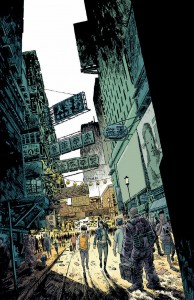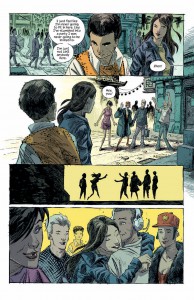Trees #4
Written by Warren Ellis
Art by Jason Howard
Published by Image Comics
Finally, the plot has gotten a bit of a nudge in this issue. It’s still not going anywhere quickly, and there are only hints of action yet to come that are foreshadowed here. Finding reasons to keep reading this series is difficult, meaning that this comic is really leaning heavily on its conclusion to give the whole thing any worth. The publicity for this issue says that “A storm is coming.” If so, it’s certainly taking its sweet time.
In Svalbard, Marsh has figured out what those mysterious black roses are. They’re not plants, as it turns out, but some sort of mechanical construct that obstructs radio waves. The Marsh argues with the station chief, who doesn’t want to keep them and demands that he take his vacation. He refuses stating he’s finally on the verge of understanding these mysterious constructs, which is his whole reason for being there in the first place. Elsewhere, in China, Chenglei explores the city with the older woman and finds a platform where he can observe the city and draw. The issue ends with the French journalist learning of military action in Somalia.
 Thematically, this is the most interesting we’ve had thus far. For once, we actually get to see some of the physical effects the Trees are having on the environment; specifically, the piece in China is the most interesting. The presence of the Tree is implied to have altered the social fabric of the city, creating a far more liberal and open environment than what is found elsewhere. As for Somalia, the Tree has simply changed the balance of power in the region, ending a previously stable power dynamic.
Thematically, this is the most interesting we’ve had thus far. For once, we actually get to see some of the physical effects the Trees are having on the environment; specifically, the piece in China is the most interesting. The presence of the Tree is implied to have altered the social fabric of the city, creating a far more liberal and open environment than what is found elsewhere. As for Somalia, the Tree has simply changed the balance of power in the region, ending a previously stable power dynamic.
Some overdue action in the story does not change the fact that this is a very slow comic. There’s  nothing inherently bad in writing a comic that takes its time to reveal certain mysteries, but it certainly helps to have some interesting characters to move the action along. Even worse, most of the characters are mouthpieces for the plot, with no real depth to them, and no backstory to give them an individual identity.
nothing inherently bad in writing a comic that takes its time to reveal certain mysteries, but it certainly helps to have some interesting characters to move the action along. Even worse, most of the characters are mouthpieces for the plot, with no real depth to them, and no backstory to give them an individual identity.
Thus far, Trees hasn’t given the reader much reason to keep reading, with far too many perspectives that are barely covered in any given issue (does anybody even remember the Tree in New York?). The interesting parts, such as Svalbard and China, seem shortchanged by the less-interesting or less-developed sections. Unfortunately, readers might just need to wait another several issues before the action fully plays out.

